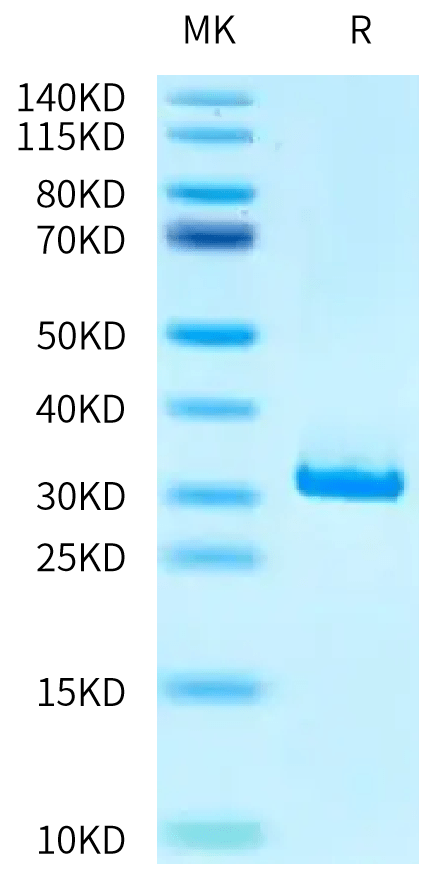| Weight | 1 lbs |
|---|---|
| Dimensions | 9 × 5 × 2 in |
| accession | P00920 |
| express system | HEK293 |
| product tag | C-His |
| purity | > 95% as determined by Tris-Bis PAGE;> 95% as determined by HPLC |
| background | Carbonic anhydrase II (CA II) is a zinc metalloenzyme that catalyzes the reversible interconversion of water and CO2 to bicarbonate and a proton. CA II is abundant in most cells, and plays a role in numerous processes including gas exchange, epithelial ion transport, respiration, extra- and intracellular pH control, and vascular regulation. |
| molecular weight | The protein has a predicted MW of 29.99 kDa. Due to glycosylation, the protein migrates to 30-35 kDa based on Tris-Bis PAGE result. |
| available size | 100 µg, 500 µg |
| endotoxin | Less than 1EU per μg by the LAL method. |

Mouse CA2/Carbonic anhydrase II Protein 2318
$270.00 – $900.00
Summary
- Expression: HEK293
- Active: Yes (catalytic)
- Amino Acid Range: Ser2-Lys260
Mouse CA2/Carbonic anhydrase II Protein 2318
| protein |
|---|
| Size and concentration 100, 500µg and liquid |
| Form Liquid |
| Storage Instructions Valid for 12 months from date of receipt when stored at -80°C. Recommend to aliquot the protein into smaller quantities for optimal storage. Please minimize freeze-thaw cycles. |
| Storage buffer Shipped with dry ice. |
| Purity > 95% as determined by Tris-Bis PAGE |
| target relevance |
|---|
| Carbonic anhydrase II (CA II) is a zinc metalloenzyme that catalyzes the reversible interconversion of water and CO2 to bicarbonate and a proton. CA II is abundant in most cells, and plays a role in numerous processes including gas exchange, epithelial ion transport, respiration, extra- and intracellular pH control, and vascular regulation. |
| Protein names Carbonic anhydrase 2 (EC 4.2.1.1) (Carbonate dehydratase II) (Carbonic anhydrase II) (CA-II) (Cyanamide hydratase CA2) (EC 4.2.1.69) |
| Gene names Ca2,Ca2 Car2 |
| Protein family Alpha-carbonic anhydrase family |
| Mass 10090Da |
| Function Catalyzes the reversible hydration of carbon dioxide (By similarity). Can also hydrate cyanamide to urea (By similarity). Involved in the regulation of fluid secretion into the anterior chamber of the eye (By similarity). Essential for bone resorption and osteoclast differentiation (By similarity). Contributes to intracellular pH regulation in the duodenal upper villous epithelium during proton-coupled peptide absorption (By similarity). Stimulates the chloride-bicarbonate exchange activity of SLC26A6 (By similarity). |
| Catalytic activity BINDING 94; /ligand="Zn(2+)"; /ligand_id="ChEBI:CHEBI:29105"; /ligand_note="catalytic"; /evidence="ECO:0000250|UniProtKB:P00918"; BINDING 96; /ligand="Zn(2+)"; /ligand_id="ChEBI:CHEBI:29105"; /ligand_note="catalytic"; /evidence="ECO:0000250|UniProtKB:P00918"; BINDING 119; /ligand="Zn(2+)"; /ligand_id="ChEBI:CHEBI:29105"; /ligand_note="catalytic"; /evidence="ECO:0000250|UniProtKB:P00918"; BINDING 198..199; /ligand="substrate"; /evidence="ECO:0000250|UniProtKB:P00918" |
| Subellular location Cytoplasm. Cell membrane. Note=Colocalized with SLC26A6 at the surface of the cell membrane in order to form a bicarbonate transport metabolon. Displaced from the cytosolic surface of the cell membrane by PKC in phorbol myristate acetate (PMA)-induced cells. |
| Structure Interacts with SLC4A4 (By similarity). Interaction with SLC4A7 regulates SLC4A7 transporter activity (By similarity). Interacts with SLC26A6 (By similarity). |
| Target Relevance information above includes information from UniProt accession: P00920 |
| The UniProt Consortium |
Data
Publications
Publications
| pmid | title | authors | citation |
|---|---|---|---|
| We haven't added any publications to our database yet. | |||
Protocols
| relevant to this product |
|---|
Documents
| # | ||
|---|---|---|
| Please enter your product and batch number here to retrieve product datasheet, SDS, and QC information. | ||

















